- Futures on Dow fell 0.8%, on the S&P down 0.75% after Monday's strong gains
- China shares climbed for a 6th day, its longest upward streak since February
- Oil slumps, but clings to $40 level
Key Events
The global equity rally in stocks faltered on Tuesday, after a robust open to the trading week extended risk appetite after the best quarter for US equities in decades. This morning, however, US futures for the Dow Jones, S&P 500, NASDAQ and Russell 2000 were down, and European stocks erased Monday’s gains. Asian shares were primarily in the red as well, though the Shanghai Composite eked out a gain.
The dollar rebounded, even as yields dropped. Oil wiped out Monday’s increases.
Global Financial Affairs
Contracts on all four major US indices were lower, with futures for the Russell 2000 underperforming at time of writing, (-1.4%). Contracts on the NASDAQ weren't quite so pressured, (-0.4%), after the underlying index posted a fresh record high during Monday's New York session.
Perhaps, investors decided to lock in profits today. As well, the US's top, infectious disease authority, Dr. Anthony Fauci, warned yesterday that the nation is “still knee deep in the first wave,” of the coronavirus as hospitalizations skyrocket across the Sun Belt, a region that includes Florida, Texas and Arizona, all states that were once Republican—and Trumpian—strongholds, something that may now be changing.
Healthcare firms and banking industry shares pulled the Stoxx Europe 600 lower, after German Industrial Production disappointed, underscoring just how much of an uphill climb it is for any economy emerging from a lockdown.
Asian stocks failed to follow Monday's strong rally on Wall Street. Hong Kong’s Hang Seng underperformed, (-1.5%), as investors unwound positions after a 9.5% surge in the past five sessions. Technically, the index remained above both the 200 DMA and the top of a rising channel.
South Korea’s KOSPI was the region's second worst performer, (-1.1%), snapping a three-day rally, as rising cases of COVID-19 globally increased local worries. The number of confirmed cases of the virus has swelled to over 11.6 million worldwide, with 538,539 fatalities.
China’s Shanghai index was once again the regional outlier—it outperformed, (+0.4%), as momentum from an editorial in The China Securities Journal touting stock acquisition as a 'healthy' way to build the country's digital economy kept alive a surge of interest by novice investors. Though the benchmark was 2.2% higher intraday, it gave up most of that advance. Still, the gauge sealed its sixth consecutive daily climb, the longest streak since its February bottom.
On Monday, US stocks were boosted by the tech sector. The S&P 500 rallied for a fifth straight day, its longest up-move since December.
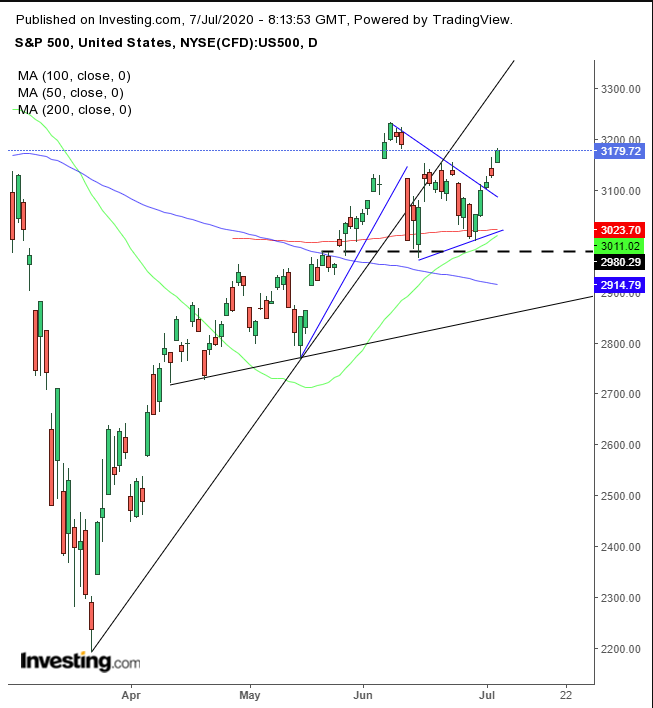
The SPX extended an upside breakout of a pennant for the third day, as the 50 DMA gets ready to make the jump above the 200 DMA, triggering a golden cross.
Amazon (NASDAQ:AMZN) made history, climbing above $3,000 per share for the first time. And Tesla (NASDAQ:TSLA) accelerated for the fifth day in a row, adding more than 40% in value over this period.
Yields, including for the US 10-year Treasury, slipped, offsetting three-and-a-half days of gains.
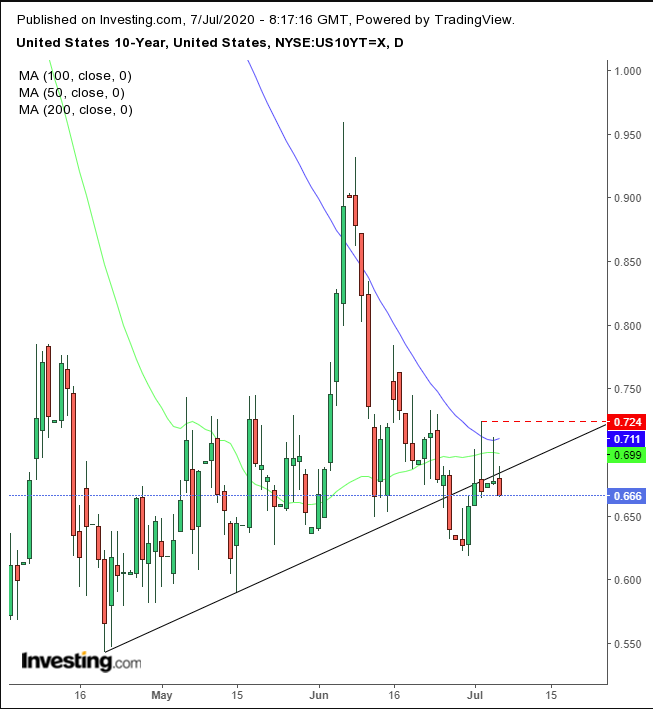
Yields fell below an uptrend since April 21, after attempting to return above it three different times.
The dollar rebounded, paring more than half of yesterday’s decline.
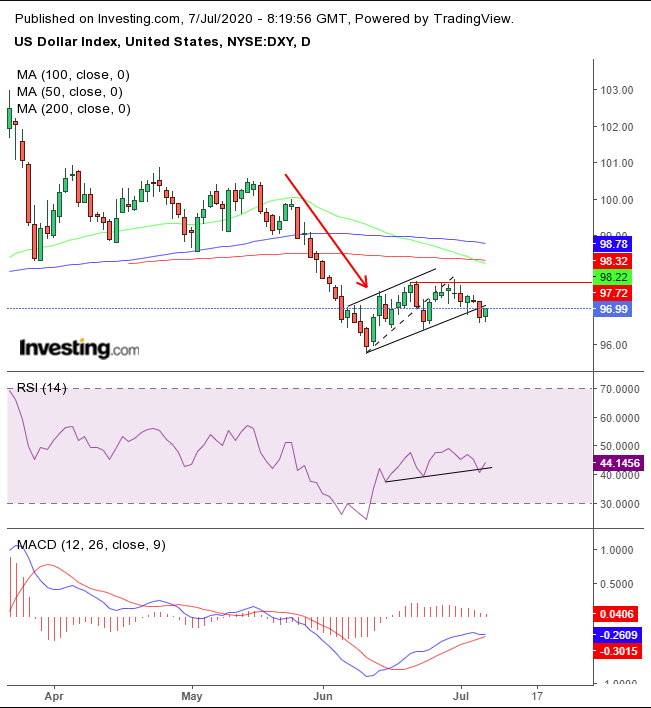
The move provided a downside breakout to a rising flag, bearish following the preceding plunge. If the price fails to climb back into the flag, it will signal a resumption of the underlying downtrend. While the 50 DMA crossed below the 200 DMA, triggering a death cross, both the RSI and the MACD held on, for now.
Dollar strength weighed on the price of gold.

The precious metal was pushed below its hourly short-term uptrend, increasing the likelihood if the commodity retesting the bottom of its hourly rising channel, probably around where it meets with the previous hourly low at $1780.
Bitcoin broke the topside of a pennant, potentially blowing out the pattern.
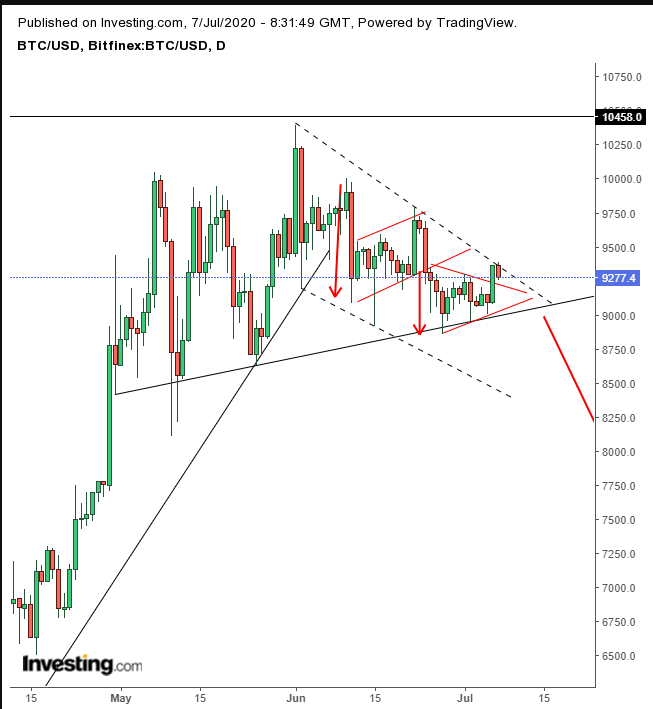
The cryptocurrency remains below the flag and within the falling channel since the June 1 high. As well, given the asset's volatility, the breakout of 1.3% is not significant.
Oil wiped out all gains from yesterday, clinging to the $40 level ahead today's weekly API stockpiles release. The data is expected to show that WTI stocks increased, even after OPEC cut output to its lowest levels since 1991 in effort to absorb the loss of demand amid the pandemic. The cuts made by Saudi Arabia remove the equivalent of seven supertankers from the market every day.
Perhaps the dollar is weighing on oil, in addition to the pressure from factors related to coronavirus.
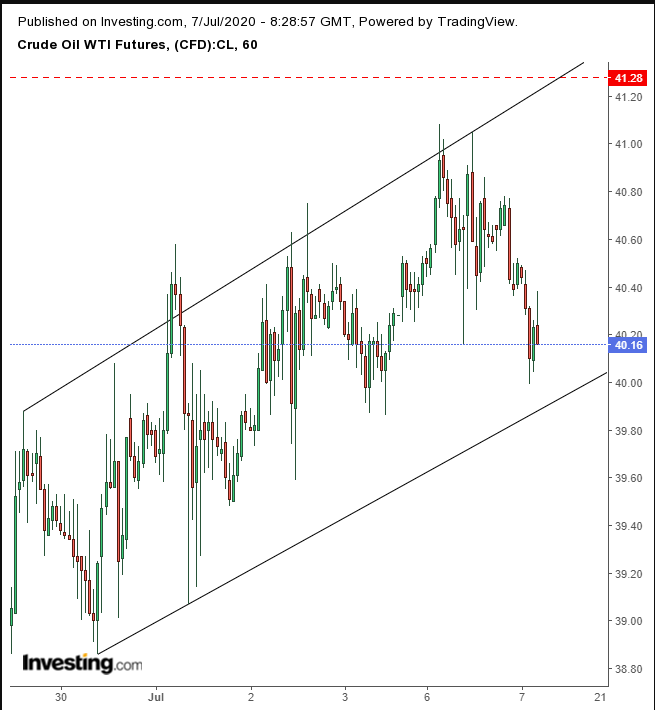
In yesterday's analysis we provided technical reasons that would turn WTI into a downtrend. However, for now, crude continues to trade within an hourly rising channel.
Up Ahead
- The EIA's crude oi inventories report comes out Wednesday.
- All eyes will once again be on weekly US Initial Jobless Claims which prints on Thursday.
- Singapore holds its general election on Friday.
Market Moves
Stocks
- Futures on the S&P 500 Index declined 0.6%.
- The Stoxx Europe 600 Index fell 0.7%.
- The MSCI Asia Pacific Index dipped 0.5%.
- The MSCI Emerging Markets Index dipped 0.6%.
Currencies
- The Dollar Index jumped 0.2%.
- The euro decreased 0.1% to $1.1294.
- The British pound dipped 0.1% to $1.2481.
- The onshore yuan was little changed at 7.022 per dollar.
- The Japanese yen weakened 0.2%, slipping to 107.55 per dollar.
Bonds
- The yield on 10-year Treasurys dipped one basis point to 0.67%.
- The yield on two-year Treasurys decreased less than one basis point to 0.15%.
- Germany’s 10-year yield fell two basis points to -0.45%.
- Britain’s 10-year yield sank two basis points to 0.183%.
- Japan’s 10-year yield dipped less than one basis point to 0.037%.
Commodities
- West Texas Intermediate crude sank 1.3% to $40.11 a barrel.
- Brent crude fell 1.2% to $42.59 a barrel.
- Gold weakened 0.1% to $1,783.26 an ounce.
